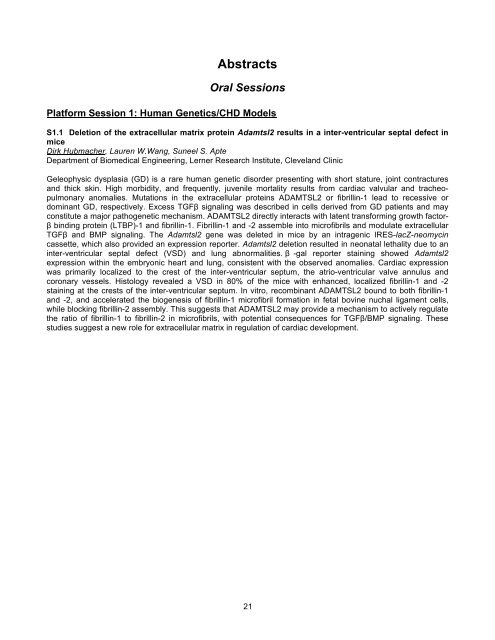Abstract Book Cover - Weinstein 2012 - University of Chicago
Abstract Book Cover - Weinstein 2012 - University of Chicago
Abstract Book Cover - Weinstein 2012 - University of Chicago
You also want an ePaper? Increase the reach of your titles
YUMPU automatically turns print PDFs into web optimized ePapers that Google loves.
<strong>Abstract</strong>s<br />
Oral Sessions<br />
Platform Session 1: Human Genetics/CHD Models<br />
S1.1 Deletion <strong>of</strong> the extracellular matrix protein Adamtsl2 results in a inter-ventricular septal defect in<br />
mice<br />
Dirk Hubmacher, Lauren W.Wang, Suneel S. Apte<br />
Department <strong>of</strong> Biomedical Engineering, Lerner Research Institute, Cleveland Clinic<br />
Geleophysic dysplasia (GD) is a rare human genetic disorder presenting with short stature, joint contractures<br />
and thick skin. High morbidity, and frequently, juvenile mortality results from cardiac valvular and tracheopulmonary<br />
anomalies. Mutations in the extracellular proteins ADAMTSL2 or fibrillin-1 lead to recessive or<br />
dominant GD, respectively. Excess TGFβ signaling was described in cells derived from GD patients and may<br />
constitute a major pathogenetic mechanism. ADAMTSL2 directly interacts with latent transforming growth factorβ<br />
binding protein (LTBP)-1 and fibrillin-1. Fibrillin-1 and -2 assemble into micr<strong>of</strong>ibrils and modulate extracellular<br />
TGFβ and BMP signaling. The Adamtsl2 gene was deleted in mice by an intragenic IRES-lacZ-neomycin<br />
cassette, which also provided an expression reporter. Adamtsl2 deletion resulted in neonatal lethality due to an<br />
inter-ventricular septal defect (VSD) and lung abnormalities. β -gal reporter staining showed Adamtsl2<br />
expression within the embryonic heart and lung, consistent with the observed anomalies. Cardiac expression<br />
was primarily localized to the crest <strong>of</strong> the inter-ventricular septum, the atrio-ventricular valve annulus and<br />
coronary vessels. Histology revealed a VSD in 80% <strong>of</strong> the mice with enhanced, localized fibrillin-1 and -2<br />
staining at the crests <strong>of</strong> the inter-ventricular septum. In vitro, recombinant ADAMTSL2 bound to both fibrillin-1<br />
and -2, and accelerated the biogenesis <strong>of</strong> fibrillin-1 micr<strong>of</strong>ibril formation in fetal bovine nuchal ligament cells,<br />
while blocking fibrillin-2 assembly. This suggests that ADAMTSL2 may provide a mechanism to actively regulate<br />
the ratio <strong>of</strong> fibrillin-1 to fibrillin-2 in micr<strong>of</strong>ibrils, with potential consequences for TGFβ/BMP signaling. These<br />
studies suggest a new role for extracellular matrix in regulation <strong>of</strong> cardiac development.<br />
21


